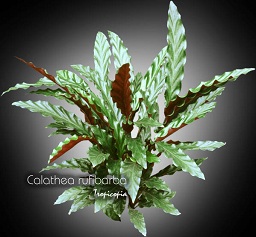Table of contents
Velvet Calathea

Latin Name: Calathea rufibarba
Category: Foliage plant
Family: Marantaceae
Origin: Brazil
Climate: Tropical
Growing Zones: 11
Care Instructions
The Velvet Calathea (Calathea rufibarba) is a tropical plant that originates from Brazil. This foliage plant plant belongs to the Marantaceae family and is well-suited for growing in USDA zones 11.
Complete Care Guide for Velvet Calathea (Calathea rufibarba)
Watering Requirements
The Velvet Calathea, known for its stunning foliage, thrives in consistently moist soil. It is essential to water your Calathea regularly, ensuring that the top inch of soil remains damp but not soggy. Overwatering can lead to root rot, while underwatering can cause the leaves to curl and become crispy. A good rule of thumb is to water your Calathea once a week, adjusting frequency based on the humidity levels in your home. During the growing season (spring and summer), you may need to increase watering slightly, while in the dormant months (fall and winter), reduce the frequency. Always use room temperature water, as cold water can shock the plant.
Light Conditions
Velvet Calathea prefers bright, indirect light. Direct sunlight can scorch its beautiful leaves, leading to unsightly brown patches. Ideally, place your Calathea near a north or east-facing window where it can receive filtered light. If you notice the leaves losing their vibrant colors or becoming leggy, it may be a sign that it needs more light. Conversely, if the leaves start to fade or develop brown edges, it may be receiving too much direct sunlight. If natural light is limited, consider using a grow light to supplement its needs, ensuring it mimics the gentle, indirect light the plant craves.
Soil Preferences
For optimal growth, Velvet Calathea thrives in a well-draining, rich potting mix. A blend of peat moss, perlite, and orchid bark works wonders, providing the necessary aeration and moisture retention. This combination allows the roots to breathe while preventing waterlogging. Additionally, consider incorporating a slow-release fertilizer during the growing season to provide essential nutrients. Fertilizing every 4-6 weeks with a balanced, water-soluble fertilizer can help maintain vibrant foliage. Be cautious not to over-fertilize, as this can lead to salt buildup in the soil, which can harm the plant.
Pests and Diseases
While Velvet Calathea is relatively resilient, it can be susceptible to common houseplant pests such as spider mites, aphids, and mealybugs. Regularly inspect the undersides of the leaves for any signs of infestation. If you notice small webs or sticky residue, it may indicate spider mites. Treat infestations promptly with insecticidal soap or neem oil, ensuring thorough coverage of the affected areas. Additionally, Calathea can suffer from leaf spot diseases, often caused by overwatering or high humidity. To prevent this, ensure good air circulation around the plant and avoid getting water on the leaves. If leaf spots appear, remove affected leaves and adjust your watering routine.
Special Care Tips
To keep your Velvet Calathea thriving, consider the following special care tips: First, maintain a high humidity level, ideally between 50-60%. This can be achieved by misting the leaves regularly, using a pebble tray filled with water, or placing a humidifier nearby. Calathea plants are sensitive to fluoride and chlorine found in tap water, so using distilled or rainwater is recommended. Additionally, rotate your plant every few weeks to ensure even growth and prevent it from leaning towards the light source. Lastly, be patient; Calathea can be finicky, but with the right care, it will reward you with its stunning, velvety leaves.








